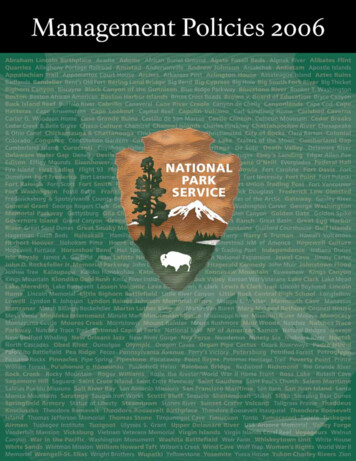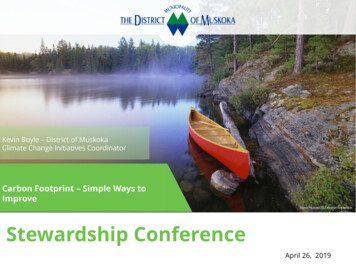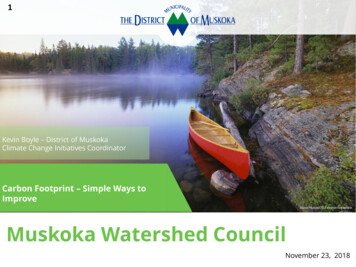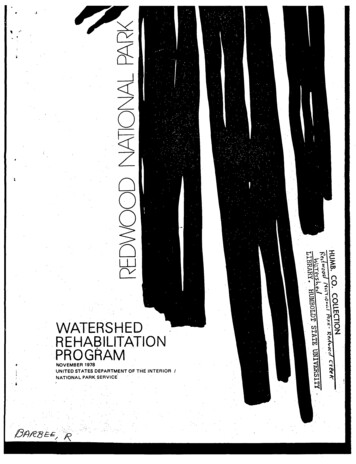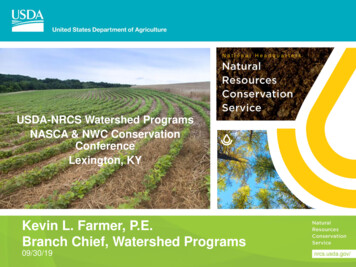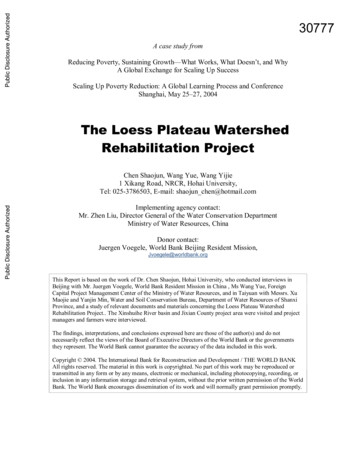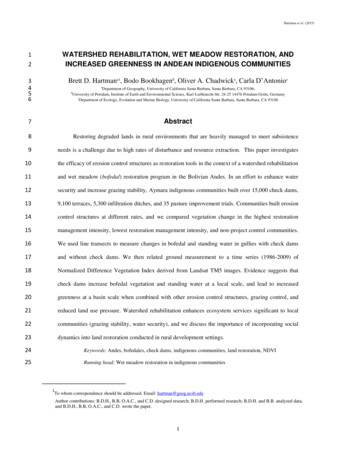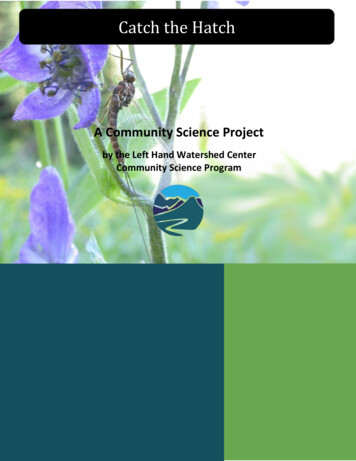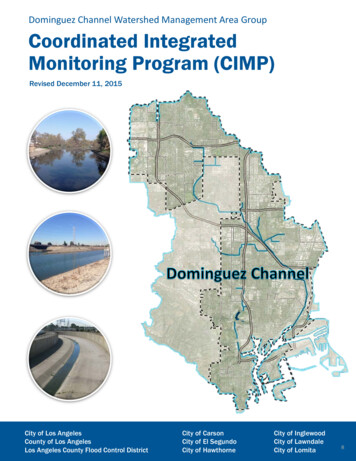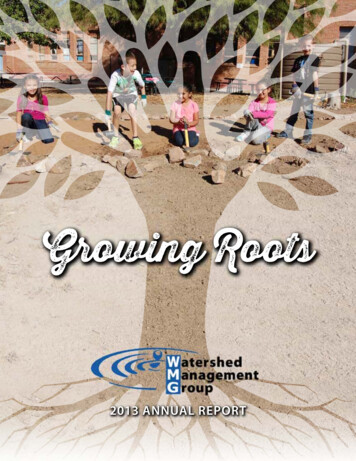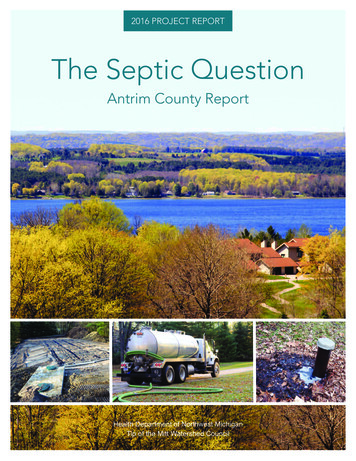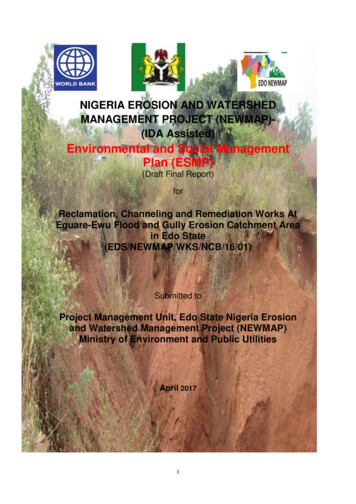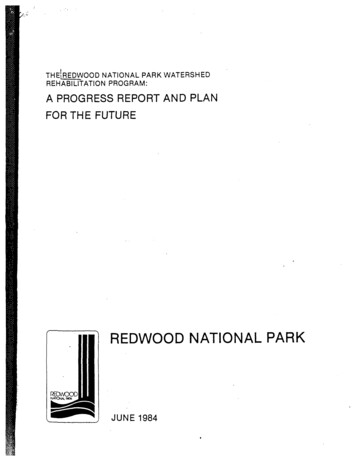
Transcription
THEIREDWOOD NATIONAL PARK WATERSHEDREHABILITATION PROGRAM:A PROGRESS REPORT AND PLANFOR THE FUTUREREDWOOD NATIONAL PARKJUNE 1984
- CONTENTS PLISHMENTS 1977 - 19831I.II.INTRODUCTI ON3A.B.53THE WATERSHED REHABILITATION PROGRAMA.B.C.D.III.of the ProgramStaffing/Funding istorySite Specific Watershed RehabilitationRevegetationRehabilitation Monitoring, Documentation and EvaluationTimber Harvest Plan Reviews182127A.B.2730D.GeomorphologyFish and Wildlife37Environmental Policy41RESOURCES MANAGEMENT43A.Role and FunctionB. summarC. Accomp ishments434343COOPERATIVE PARK STUDIES UNIT49lV.716TECHNICAL SERVICESC. "EUl tural ResourcesIV.7494949THE FUTURE - 1984 - lr n1!.r. 1 52INTRODUCTI ON54THE AT RSP.EOREHABILITATIONA.B.C.D.Si te Sped fi c Watershed Rehab;, '; . '. '.; or.RevegetationGeological MonitoringTimber Harvest Plan ReviewPR0GP 59sSt596"; )iii d
III.TECHNICAL SERVICES67A.B.C.D.67697173GeomorphologyFish and WildlifeCultural ResourcesEnvironmental Policy75IV. RESOURCES MANAGEMENTA.B.C.D.E.F.V.Soils StudiesVegetation Management/StudiesBear ManagementElk ManagementBoundary FencingFeral Pig ControlCOOPERATIVE PARK STUDIES UNIT77A.B.C.D.77777777Second Growth Forest StudiesAlluvial VegetationVegetation MappingOld Growth Redwood Forest EcologyTHE FUTURE: 1991 AND BEYOND79I. INTRODUCTIONII.75757676767681RESOURCE MANAGEMENT CONCERNS BEYOND 199185A.B.8585c.D.E.F.Rehabilitation Evaluation - A Final ReportVegetation ManagementGeomorpholo yFish and Wi dlifeEnvironmental PolicyTimber Harvest Plans and APHY OF REDWOOD NATIONAL PARK PUBLICATIONSWATERSHED REHABILITATION PLAN SCHEDULES AND MAPiv9394107
-.;.ILLUSTRATIONSLIST OF TABLESPage1.2.3.4.5.6.7.8.9.Watershed Rehabilitation ExpendituresFiscal year 1983 Program FundingSummary of Erosion Control Activities in RedwoodNational Park 1977 - 1983Revegetation Project AccomplishmentsSummary of Annual Timber Harvest Reviews1983 Timber Harvesting ActivityGeomorphology Project StatusFish and Wildlife Project StatusRoad Removal Schedule569172323293260LIST OF FIGURESf.a 1.2.3.4.5.6.7.8.9.10.11.Watershed Rehabilitation Projects in Redwood National ParkAcres of Cutover Land RehabilitatedMiles of Logging Road RehabilitatedAnnual Rehabilitation Costs by Type of TreatmentRedwood National Park and the Redwood Creek BasinResource Management Division Flow ChartTechnical Services Division Flow ChartArcata Office OrganizationFuture Watershed Rehabilitation in Redwood National ParkWatershed Rehabilitation in Redwood National ParkProposed Resources Management Divisionv810101222565758616283
climate was typical of the climate.whithcharacterized the past 3,000years. Therefore, major'storms typi ca 1 of the peri od 1950-.1975 shaul doccur more· frequently duri ng the next few years than woul d bepredicted based upon the climate of the last decade.· For example (using a long term climatological perspective) the major storm ofDecember 1964' probably has a recurrence interval. of 45-50 years.Similarly the storms of 1955, 1972 ,and 1975 have recurrence intervalsof 30,10 and 10 years respectively.Fluvial Erosion: Gully erosion was assessed On 32 study plots locatedin cutover 1ands in the Redwood Creek watershed. These surveys s.howedvirtually all gully erosion was associated with roads, and the largestroads were the greatest sediment source. Stream diversions were themost important single cause of erosion. The most important· gullyerosion preventive measure was careful construction practices used onmajor logging haul rOijds. Oak-woodland and grassland soils were foundto·be more susceptible than forest soils to gully erosion from roadcaused stream d.iversion.Landsliding: Total landslide contribution to the Redwood Creek basinbetween 1954 and 1980 was 6,415,600 01 3 , of whi ch 82 percent occurredeither during r before the December 1964 flood.Aerial photointerpretation showed most of this landslidingoccurred during thisstorm. There were two high landslide volume reaches along the 100 km1ength of Redwood Creek. One was located along the uppermost 30 km,the 6the extended from the downstream end of Redwood Valley to BridgeCreek.· Low 1ands 1ide occu rrence reaches became areas of maximumsediment storage due to their lower gradient and greater valley width.Sa,ndstone slopes were more prone to large landslides than schistslopes. .B . Fi sh and Wil dl ife1.Role and functionFish and wildlife staff study the nature, function, and dynamics ofaquatic and terrestrial ecosystems and determine man's influence uponthese systems and their biologic components. Studies and monitoringof fish and wildlife communities, populations and the park environmentare· undertaken to provide basic resource information needed toeffectively manage and protect. the park's fish and wildlife.Information is prOVided for park management and other division staffto foster understanding and appreciation 6f park fish and wildlife toguide park developments, to avoid harm to park visitors and to providefor restoration· and protection of park resources.Staff preparemanagement plans to provide for a balanced, diverse, naturallyfunctioning and self-perpetuating biological park community whichprovides adequate protection for threatened or endangered species and. their habitat.30'.:'
".2.SummaryResearch begun during 1980 within the Redwood Creek estuary revealedthe value of the estuary for downstream migrating juvenile salmonidfish and the adverse effects of channel ization and construction offlood control levees on the function of the embayment. Short termmanagement was impl emented fo 11 owi ng pub 1i c revi ew and an assessmentof various short and long term alternatives. Water levels weremaintained high enough to provide suitable habitat for downstream fishmigrants, but low enough to prevent flooding of adjacent pastures.Track i ng 0 f b1ack bears with i nth epa r k yi e1de d val uab1e i nforma t ionon bear behavior, home range, selective utilization of cutover and oldgrowth forests, seasonal physical condition, reproduction, and bearpopulation age and sex composition.Aquatic invertebrates of the Redwood Creek watershed were studied toassess the impacts of watershed restoration activities within smallstreams on downstream aquatic biological resources.Other studies included: Cold pool formation and use by fish assanctuaries· during warm summer months; elk management planning;fi shery impacts of the proposed 101 bypass hi ghway; fi sh habitatmanagement planning; Redwood Creek salmonid nursery area surveys andriver otter research. See Table 8 for the status of fish and wildlifeprojects.3.AccomplishmentsAquatic Invertebrate Surveys:Aquaticinvertebratesrepresentthemajor source of food for juvenile anadromous fish and have been usedas indicators of stream quality. Species identification and abundancewere measured to observe stream changes over time. Surveys wereinitiated to determine aquatic invertebrate species distribution andabundance in streams of the Redwood Creek watershed.The first objective of the aquatic invertebrate study was aqualitative survey of larger park streams in the Redwood Creek basin.Sri dge Creek, Devil s Creek, Tom McDonald and Emerald Creeks weresampled April through October 1980. The survey duplicated objectivesof the USGS efforts duri ng thei r 1973-1975 survey, except improvedsampling techniques were employed. The survey resulted in an aquaticinvertebrate species list and a desc iption of their relativeabundance. These examples will be used to describe baseline streamconditions for comparison with the results from future samplings. Inorder to use aquatic invertebrate monitoring as a resource managementtool, a quantitative technique was developed to sample small streams.A small artificial substrate basket was designed which could samplestreams as shallow as 5 cm. without disturbing the substrate (manyconventional sampling devices require the substrate to be disturbed aspart of the collection process). The sampler collected a lower number31
TABLE 8Fish and Wildlife Project StatusProject Title/Objective.YearInitiatedStatusAquatic Invertebrate Surveys Determine species and abundanceof fish food organisms inRedwood Creek streams.80Surveys completed. Samplesstill being processed. Preliminary species list available.Evaluation of techniques forcollection/analyiis of aquaticinvertebrate communities.81Field work completed. Mastersthesis produced. Draft technical report prepared. "New"sampler developed. Technicalpaper prepa red.Determination of aquatic community impacts resulting fromwatershed rehabilitation.81Initial field work completed.Draft report prepared. Management recommendations prepared. Follow-up field workto be conducted.Redwood Creek Estuary Research To determine feasibility ofde lopi g rehabilitation alternatives for the Redwood Creekestuary.80Initial geologic work completedand Masters thesis produced.Technical papers prepared.Management Alternatives for theRedwood Creek Estuary preparedPublic meetings conducted.Management alternatives developeand implemented. FisheriesResearch continuing.River Otter Research - Determinestatus and effects of loggingon distribution/abundance of otters.80Field work completed FY83.analysis underway. Targetcompletion date in FY84.DataRedwood Creek Salmonid NurseryArea Study- Determine quantity,quality and distribution ofjuvenile salmonid nursery areas inRedwood Creek basin.81Field work completed FY82.Technical paper prepared. Dataanalysis continuing. FY84 targ etcompletion date.132
TABLE 8 (continued)Fish and Wildlife Project StatusYearInitiatedProject Title/ObjectiveStatusBlack Bear Research - Determinehabitat selection patterns anddistribution of black bear in thecutover redwood forest ecosystem.Develop comprehensive Bear Management" Pl an.81Field work continuing. Ninebears radio-collared. Draftbear management plan prepared.Technical paper prepared.Target completion FY86.Roosevelt Elk Management - AssistDepartment of Fish and Game inalleviating lk depredation onproperty adjacent to park.81Prepared assessments for 1982and 1983 relocation efforts.24 elk relocated. Assist indeveloping interagency regionalelk management plan. Ongoing.Fisheries Habitat ManagementPlans - Develop stream specifichabitat management plans forfisheries enhancement.81Preliminary work begun in BridgeCreek. Permanent monitoringsites established. Ongoing.Evaluation of Impacted from Proposed construction of U.S. 101hi ghway bypass.80Field work completed necessaryfor predictive information. Impact analysis prepared. Technical paper prepared. Evaluationsshould continue during and following construction phase ofproject.Cold Pool Research - Determinedistribution, abundance and'importance of cold pools as criticalrearing habitat to juvenilesalmonids. Develop managementrecommendations for enhancing/creating new cold pools.82Cold pools for two summerslocated/mapped. Two technicalpapers prepared. Researchcontinuing and ongoing.Roosevelt Elk Research - Determinehabitat selection patterns anddistribution of Roosevelt elk inthe cutover redwood forestecosystem Develop alternativesfor management.83Study plan being developed.Field work to begin FY84.Target completion date 1989.33-----------------------------------
'-of total individualsinvertebrate samplerwildland situationsaquatic community atbut a comparable number of taxa. The result was anwhich could be more readily transported for use inand which produced representative sarr.ples of thea much lower cost.Ouri ng the summer of 1981, the immedi ate effects of road cross in']excavation on the downstream aquatic community was studied on two secondorder streams within the park.The results of the investigat1unindicated the standard practice to divert streamflow around roadcrossing excavations was neither practical nor necessary. DuE.' to themorphology of such streams, sediment produced by rehabi 1itationwcrkeither settled out quickly or did not produce a significant chanQe r.the aquatic community.Another study was conducted to monitor the colonization of a new streamchannel during the first SU(T'rner following excavation and to observebiological recovery after one year. As part of the colonization study,drift organisms were sampled hourly over a 24-hour period to determineavailability of colonizing organisms. This study showed high numbers ofaquatic invertebrates colonized the channels during the first summerfollowing the excavation, but that community composition changed. Oneyear after th excavation, there was no significant difference betw onthe aquatic community of the new channel and a section of chi:!. I-( :upstream from the rehabilitation worksite.Redwood Creek Estuarx:Studies were initiated to determine thefeasibility of developlng rehabilitation alternatives for the Red. fcodCreek estuary. The estuary was modified as a result of channelizationand flood control levees completed in 1968. Data on both physical andbiological estuarine processes to determine seasonal timing anddistribution of fish and fish food organisms in the estuary, determineseasonal changes in water qual ity and analyze and compare present-daypatterns of inundation, estuarine morphology and sedimentation.Prel iminary research was used to develop short term managementalternatives to minimize fisheries resource impacts Continued studieswill refine information on fish use of the estuary, on estuarineproductivity and on feasible long term rehabilitation alternatives. Theestuary's importance to anadromous fish has been establ ished. Until theflood control levees are modified to restore former circulation patternswithin the embayment, the overall effectiveness of erosion controlrehabilitation efforts occurring upstream and- restoration of the fisheryresources of the Redwood Creek watershed cannot be realized.Research results were presented in technical presentations at symposiaand in Jv1anagement Alternatives for the Redwood Creek Estuary. Publ icmeetings were conducted to disseminate research findings and to receivepublic comments on proposed alternatives.Redwood Creek Nursery Area Study:Dependi ng upon speci es, juven il esalmonids spend a rearing period in freshwater before entering the
I iocean. The availability and quality of nursery habitat determines theability of fish to survive this rearing period. A study was undertakento determine the quantity, quality and distribution of nursery habitatin the Redwood Creek basin. It was found that many tributary streamswere not available to anadromous salmonids. Natural barriers to upstream migration occur near their mouths. Within park boundaries onlythree Redwood Creek tributary streams (excluding Prairie Creek and itstributaries) were free of such barriers.Fisheries Habitat: Erosion and sedimentation damages fish spawning andrearing habitat in different ways and to varying degrees w.ithinindividual tributary streams.Therefore, rehabilitation/managementalternatives effective in one stream may not be so in another. Specificrehabilitation/management plans should be developed for each stream.Accordingly, stream surveys were conducted to identify potentialspawning sites, rearing area availability, type and quality of cover andfish food availability. Permanent sampling sites were established forlong-term monitoring of stream conditions.Complete physical andbiological characteristics and stream stability of sampling sites wererecorded. Stream stabil Hy was an extremely important characteri sticaffecting the duration and cost-effectiveness of management measures.Investigation revealed .widely used fish enhancement measures like gabionweirs or egg hatch boxes would not effectively improve fisheries inRedwood Creek. Likewise, some streams were unstable, having constantlyreadjusting channel, riffle and pool locations. Streams proposed forrehabilitation/management planning would emphasize restoration ofrearing habitat. Development of a Bridge Creek habitat management planwas begun.Highway 101 Bypass: Data on fish and wildlife resources within theimpact area of the proposed highway's alternative routes wereunavailable when project planning began.Studies were begun,concentrating on aquatic resources, that would provide the informationnecessary to predict impacts from highway construction. Data collectedwere used in preparation of draft and final environmental documents.The potential for significant impacts was identified which resulted inabatement measure committments and mitigation money from the CaliforniaD:partment of Transportation. A new technique, developed in concertwlth the California Department of Fish and Game, was used to assessfishery values of project affected streams. A technical paper wasprepared which describes the procedure. Studies to monitor impacts willresume during project construction.Cold Pool: During Redwood Creek fishing habitat studies, cold poolswhich serve as summertime habitat for juvenile salmonids werediscovered. When the mixing of cold groundwater with mainstem water wasret rded by a gravel bar or large organic 'debris, a cold pool formed.Durlng summertime low flow conditions, mainstream temperatures increasedto levels harmful to juvenile fish. Cold pools provided sanctuaries rom elevated summertime water temperatures and therefore providedlmportant nursery habitat.Cold pool research was designed to351Iilii!IJ
investigate the distribution, abundance and use by fish of natuloccurring cold pools. This research revealed conditions favoringpool formation occurred infrequently. During Summer 1982, only icold pools were found in the lower 18 miles of Redwood Creek. Becof elevated mainstem temperatures, these cold poo'ls encompassed alall the quality nursery habitat available in the creek mainstem.either producing additional cold pools or enhancing existing cold pcsummer rearing habitat could be significantly increased.River Otter:River otters are dependent on aquatic resources, Whave been severely damaged by intense land use in northern CaliforResearch objectives were to determine the status, distributionabundance of river otters in Redwood Creek. The study was conducte ,Humboldt State University.Live-trapping, radio transmitter implantations and subsequent traclof two otters provi ded abundance and di stri buti on data. Otters \found to utilize various habitats in Redwood Creek, ranging fromestuary to small tributary streams.Black Bear: There has been a conspicuous lack of bear/human problem Redwood National Park.Prior to 1978, the National and State pacomprised a coastal band of old growth forest stretching north 1Orick to the Smith River. Compared to cutover land with its increabear. food production; 01 d growth forests represented reI atively pbear habitat. As a result bear density was greater in cutover 1awhich surrounded the parks.Hunting occurred in these areas ancnatural fear of humans was reinforced. Visitors to the parks had sm1ikel ihood for bear encounters as bears were concentrated in cutolands and avoided humans.Park expansion in 1978 encompassed laareas of cutover land and prime bear habitat was added to the park.development of trails and campgrounds occurs, people will be encoura to visit these areas.Cutover areas represent a mosaic of habitat types in various stagessuccessional revegetation.How bears select habitats and how thEhabitats change with veget tive succession are being investigated. T information can be used when planning visitor facil ities such ttreliable predictions can be made about bear/human conflicts.Objectives of the park's bear research included: Habitat selection adistribution patterns, population age and sex structure and seasonnutritional status of black bears ;n the cutover redwood ecosystemTechniques used to obtain information include live-trapping, radio-telmetry, detailed vegetation analysis and blood hematology and chemist Research documented black bears denning in north coa
THE WATERSHED REHABILITATION PROGRAM 1 3 3 5 7 A. Site Specific Watershed Rehabilitation 7 B. Revegetation 16 C. Rehabilitation Monitoring, Documentation and Evaluation 18 D. Timber Harvest Plan Reviews 21 III. TECHNICAL SERVICES A. Geomorphology B. Fish
